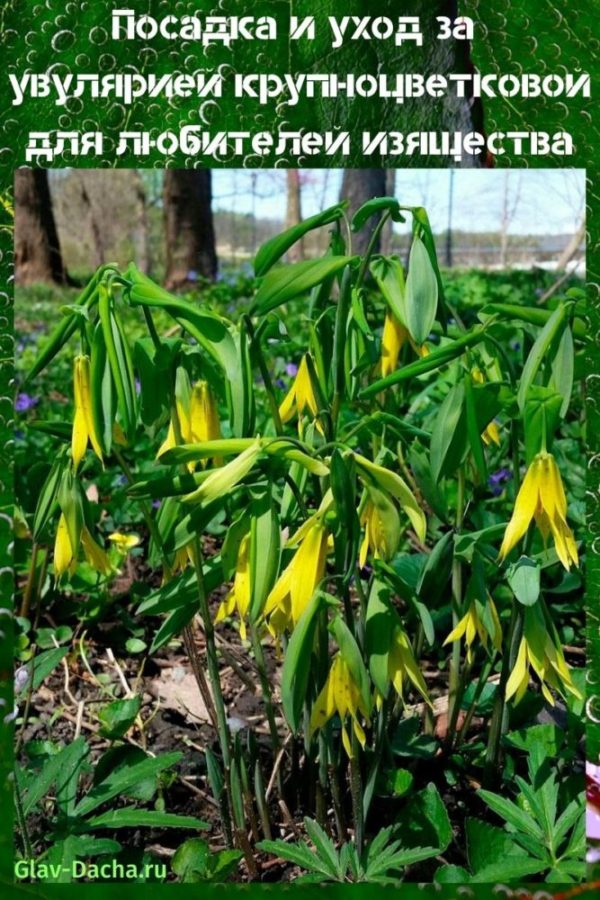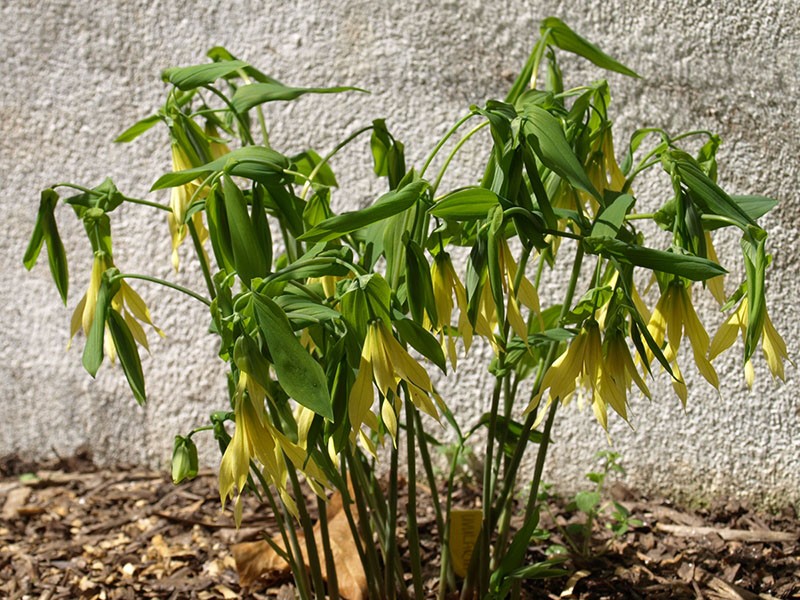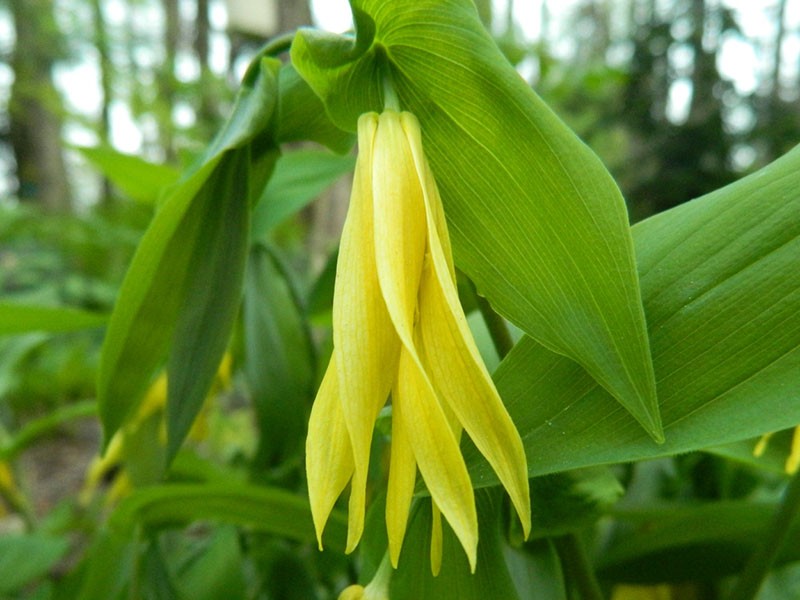Planting and caring for large-flowered uvularia for lovers of grace
 Unusual beauty flowers of a yellow hue attract the attention of passers-by with their sophistication and showiness, so many want to have such beauty in their garden. Planting and caring for the large-flowered uvularia is quite simple, since the perennial comes from the temperate subtropical zone of North America. The flowering plant is uniquely unpretentious. Moreover, many flower growers value decorative culture for its ability to grow and blossom in shady areas.
Unusual beauty flowers of a yellow hue attract the attention of passers-by with their sophistication and showiness, so many want to have such beauty in their garden. Planting and caring for the large-flowered uvularia is quite simple, since the perennial comes from the temperate subtropical zone of North America. The flowering plant is uniquely unpretentious. Moreover, many flower growers value decorative culture for its ability to grow and blossom in shady areas.
Input or description of uvularia

The shade-tolerant flower has won universal recognition not only for its ease of growing, but also for its original decorative properties. The unpretentious Uvularia grandiflora has upright branching shoots that reach a height of 40-50 cm.
Distinctive features of this type of uvularia are:
- elongated leaves (10-12 cm) of a lanceolate shape of a bright green hue, forming a kind of funnel near the stem, which creates the effect of a wrap around the shoot;
- drooping flowers up to 4 cm of a rich yellow shade on long pedicels;
- high decorativeness during the entire growing season.

A characteristic feature of the perennial is a narrow-bell-shaped corolla, consisting of deeply dissected and spiral-shaped petals (up to 6 pcs.) Of the ribbon type. During flowering, slightly pubescent foliage does not completely bloom, which gives the plant a special exotic charm.
 In early or mid-May, the decorative culture begins to bloom. You can enjoy this exquisite beauty for 3-4 weeks, until the beginning of June. It should be noted that in addition to the large-flowered uvularia, there are other types of culture. The sessile uvularia is considered the most compact, since the bush stretches only up to 30 cm. Sessile oval-elongated leaves stand out with rough edges. Showy flowers have a greenish-yellow tint. The pierced-leaved variety is similar to Grandiflora, except that it comes with thinner stems and miniature whitewashed flowers. The herbaceous culture forms luxurious lush bushes.
In early or mid-May, the decorative culture begins to bloom. You can enjoy this exquisite beauty for 3-4 weeks, until the beginning of June. It should be noted that in addition to the large-flowered uvularia, there are other types of culture. The sessile uvularia is considered the most compact, since the bush stretches only up to 30 cm. Sessile oval-elongated leaves stand out with rough edges. Showy flowers have a greenish-yellow tint. The pierced-leaved variety is similar to Grandiflora, except that it comes with thinner stems and miniature whitewashed flowers. The herbaceous culture forms luxurious lush bushes.
The representative of the genus Bezvremennikov grows due to the branched root system, located horizontally and not very deep.
Planting and caring for large-flowered uvularia at your summer cottage
 For the successful cultivation of an ornamental plant, natural conditions are created for the growth of a flower in nature. These are usually shaded areas under the crowns of large trees or bushes. A perennial thrives on slightly acidic soils with high humidity.
For the successful cultivation of an ornamental plant, natural conditions are created for the growth of a flower in nature. These are usually shaded areas under the crowns of large trees or bushes. A perennial thrives on slightly acidic soils with high humidity.
For this reason:
- too loose substrates are mixed with clay;
- heavy soil types are lightened by sand or peat;
- poor, depleted soils are fertilized with humus /compost.

"Companions" in the flowerbed for Uvularia grandiflora can be: heathers, fern varieties, hosts, aquilegia, swimsuit, astilba, as well as rhododendrons.
When considering the issue of planting and caring for large-flowered uvularia, it is worth paying attention to the depth of the groundwater. If they are located too close to the surface, then a drainage layer must be laid or a bed raising procedure is carried out.It is not recommended to plant herbaceous crops in wetlands, as well as in places of stagnant melt water.
Features of reproduction and planting
 The cultivation of Uvularia from seeds is of course carried out. Only such an instance will bloom only after 4-5 years. Since waiting is not always in the interests of the gardener, the method of dividing the bush is widely used. A plant of any age is selected for the event. At the beginning of spring or at the end of summer, the entire curtain is dug up or some part is cut off from it. With the help of a sharp object, it is divided into several parts. Each of them should have a bud of renewal (1-2 points of growth).
The cultivation of Uvularia from seeds is of course carried out. Only such an instance will bloom only after 4-5 years. Since waiting is not always in the interests of the gardener, the method of dividing the bush is widely used. A plant of any age is selected for the event. At the beginning of spring or at the end of summer, the entire curtain is dug up or some part is cut off from it. With the help of a sharp object, it is divided into several parts. Each of them should have a bud of renewal (1-2 points of growth).
All sections are disinfected:
- fungicide;
- wood ash;
- coal powder.
 The planting is done in a permanent place. A distance of 30 cm is maintained between the plants. The planting depth is determined by 5-7 cm, since the rhizomes of the flower are mainly located in the upper soil layer. The roots are neatly straightened in the hole. The earth is slightly compacted. The plot is mulched with humus or wood chips to protect against weeds and retain moisture. Until complete rooting, the seedling is watered abundantly with settled water.
The planting is done in a permanent place. A distance of 30 cm is maintained between the plants. The planting depth is determined by 5-7 cm, since the rhizomes of the flower are mainly located in the upper soil layer. The roots are neatly straightened in the hole. The earth is slightly compacted. The plot is mulched with humus or wood chips to protect against weeds and retain moisture. Until complete rooting, the seedling is watered abundantly with settled water.
Seed propagation. Sowing freshly harvested seeds is done in October or early spring. The planting material does not go much deeper, but is only sprinkled with a small amount of peat. Seedlings need regular watering and loosening.
Caring for the "unpretentious beauty"
 The main requirement for growing this subtropical perennial is proper humidity conditions. If there is a dry spring / summer, then the flower garden is watered several times a week. However, the decorative culture does not tolerate stagnant water. Therefore, the way out of the situation is to mulch the soil.
The main requirement for growing this subtropical perennial is proper humidity conditions. If there is a dry spring / summer, then the flower garden is watered several times a week. However, the decorative culture does not tolerate stagnant water. Therefore, the way out of the situation is to mulch the soil.
Uvularia also needs feeding, which are carried out in the following sequence:
- in spring, the plot is mulched with humus or rotted compost / manure (7 kg / m²);
- complex mineral compositions are introduced before flowering;
- in early autumn, the herb is fed with potassium-based fertilizers.
Wintering. Traditionally, the uvularia of grandiflora does not hide during the onset of cold weather. Nevertheless, in snowless winters, the site is covered with peat or litter.
The decorative flower is resistant to all sorts of infectious diseases and pests. However, gardeners often notice an invasion of slugs on the leaves or near the front garden, as well as snails... To combat them, insecticidal preparations are often used: Ferramol, Slizneed, Bros, Predator, Thunderstorm-3 and StopUlit. In some cases, special baits and traps are used. In addition, shellfish cannot stand the intense aromas of parsley, lavender, sage, thyme and rosemary. Therefore, many plant these plants near the garden.
Design ideas with uvularia
 Blooming in the shade is the trump card of this flower culture. Based on this, gardeners create amazing compositions in shaded corners. Spectacular perennial is used to fill the space between trees and shrubs. Refined bushes look ideal near water bodies or in lowlands.
Blooming in the shade is the trump card of this flower culture. Based on this, gardeners create amazing compositions in shaded corners. Spectacular perennial is used to fill the space between trees and shrubs. Refined bushes look ideal near water bodies or in lowlands.
Uvularia grandiflora is planted as a decorative base for:
- tui;
- junipers;
- rhododendrons;
- cypress;
- purple-leaved barberry;
- oil.

Some people prefer to create a wilderness corner on their backyards. It is in this place that a shade-tolerant plant with luxurious yellow flowers fits perfectly, which will glow in the twilight like lanterns.
 Often, an exotic flower is used to decorate borders, paths and park alleys. Ribbon mixboards or hedges are decorated with sophisticated specimens of the American herb in an original way. These touching decorations of shady grounds are used to place yellow accents in landscapes or compositions.Subject to the rules of planting and caring for uvularia, a large-flowered florist will receive a "reliable" employee in creating real masterpieces of landscape design.
Often, an exotic flower is used to decorate borders, paths and park alleys. Ribbon mixboards or hedges are decorated with sophisticated specimens of the American herb in an original way. These touching decorations of shady grounds are used to place yellow accents in landscapes or compositions.Subject to the rules of planting and caring for uvularia, a large-flowered florist will receive a "reliable" employee in creating real masterpieces of landscape design.